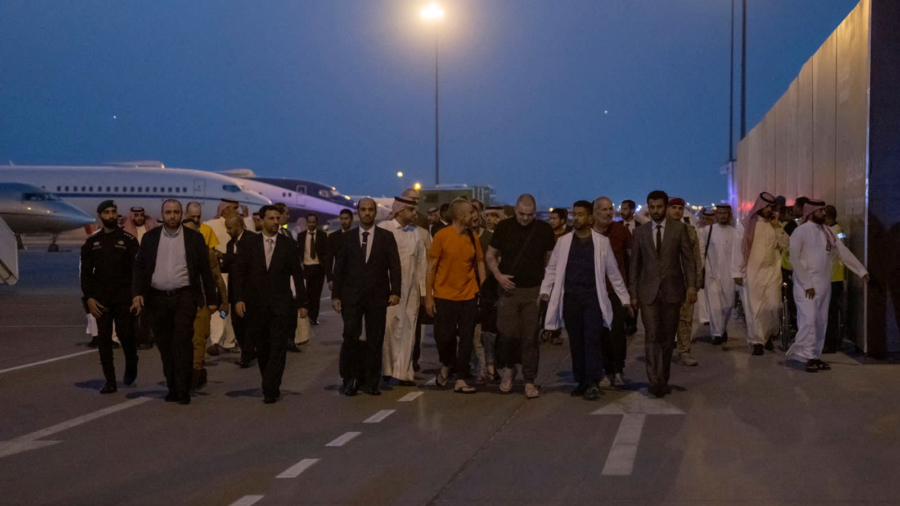Russia and Ukraine conducted a major and unexpected prisoner swap on Wednesday involving almost 300 people, among whom were 10 foreigners, as well as Ukrainian commanders who defended Mariupol in early 2022, marking the largest exchange between the two sides since Russia invaded Ukraine on Feb. 24.
The deal on Wednesday was reached with the help of Saudi Arabia and Turkey.
In the exchange, Russia released 215 Ukrainians, which included a large number of Azov fighters who sought to defend a besieged steel plant in the Ukrainian port city of Mariupol for months, before the group evacuated from the city in May in surrender to pro-Russia forces.
In return, Ukraine released 55 Russians and Ukrainians sympathetic to Russia, as well as Ukrainian Viktor Medvedchuk, the former leader of a banned Ukrainian pro-Russian opposition party who was facing treason charges.
The move comes after Russian President Vladimir Putin earlier on Wednesday announced a partial troop mobilization, saying he would use “all means available” in the event of a threat against Russia and its people. Putin’s announcement came amid recent defeats dealt to Russian troops as a result of a Ukrainian counteroffensive.
The head of the Ukrainian Presidential Office, Andriy Yermak, told Ukrainian President Volodymyr Zelenskyy that 10 foreigners were among the 215 released by Russia. They comprise five British nationals, two U.S. nationals, as well as a Croatian, a Moroccan, and a Swedish national.
Saudi Arabia had brokered an arrangement that involved flying the 10 foreigners to Saudi Arabia. The mediation involved Saudi Crown Prince Mohammed bin Salman.

Two of the British nationals—Aiden Aslin and Shaun Pinner—and the Moroccan—Brahim Saadoun—had been sentenced to death by a court in the Donetsk People’s Republic in June after they were captured fighting for Ukraine.
The two U.S. nationals who were released by Russia are both military veterans from Alabama. They were captured in the Kharkiv region of northeastern Ukraine near the Russian border on June 9. The two—Alex Drueke, 40, and Andy Huynh, 27—had traveled to Ukraine on their own.
In August, the head of the administration in Donetsk had said that a trial of captured Azov fighters would take place by the end of the summer. There was no immediate comment from Russia on Wednesday about the prisoner exchange deal, including about why it had released some of the Azov fighters who were set to go on trial.
Zelenskyy said the prisoner swap involved intense negotiations and had been under preparation for quite a long time.
“This is clearly a victory for our country, for our entire society,” he said in a video address. “And the main thing is that 215 families can see their loved ones safe and at home.”
Zelenskyy Praises Released Ukrainian Commanders
Zelenskyy thanked Turkish President Tayyip Erdogan for his help and said that five senior Ukrainian commanders would stay in Turkey until the end of the war. They include Lt. Colonel Denys Prokopenko, commander of the Azov battalion; his deputy, Svyatoslav Palamar; and Serhiy Volynsky, the commander of the 36th Marine Brigade.
The three had helped mount resistance from the bunkers and tunnels below Mariupol’s giant steel works for weeks, before they and hundreds of Azov fighters withdrew in May amid attacks from Russian-backed forces.
Zelenskyy told the five in a video call released by his office, “We’re proud of what you’ve done for our nation, proud of each and every one of you.”
The Azov battalion, a volunteer paramilitary organization, was formed in 2014 during the Donbas War in eastern Ukraine between pro-Russian forces and pro-Ukrainian forces, following a coup in February 2014, when anti-Russia, pro-EU factions overthrew then-Ukrainian President Viktor Yanukovych’s government, which was not against Russia.
Both Luhansk and Donetsk in the Donbas region had declared independence from Ukraine in April 2014 in response to the February coup.
The Azov battalion was later formally incorporated as a regiment in the National Guard of Ukraine, but not without controversy over the group’s neo-Nazi ties and the use of the wolfsangel symbol, which was also used by Nazi forces in Germany during World War II.
Putin has cited the Azov battalion’s neo-Nazi elements in his justification for invading Ukraine, calling for the “denazification” of the region.
The Azov battalion denies being fascist, and Ukraine says it has been reformed from its radical nationalist origins.
Days prior to the start of the Russia–Ukraine war, Putin had announced that Russia recognized the independence of Luhansk and Donetsk regions in eastern Ukraine. Soon after that, Putin signed a decree issued by the Kremlin that said the Russian Defense Ministry was authorized to send troops into the Luhansk and Donetsk regions to “maintain peace.”
Katabella Roberts, Reuters, and The Associated Press contributed to this report.
From The Epoch Times

